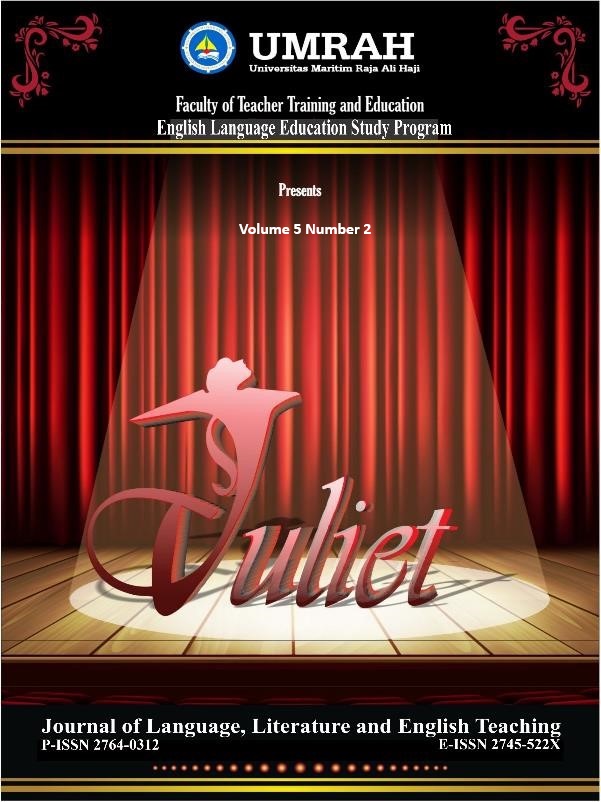Students' Perception On Duolingo in Enhancing Vocabulary Mastery
DOI:
https://doi.org/10.31629/juliet.v5i2.6859Keywords:
Students’ Perception, Duolingo, Vocabulary MasteryAbstract
The advent of technology has ushered in a plethora of engaging and innovative online learning tools for English, one of the them is Duolingo app standing out as an accessible and effective platform for language acquisition, particularly in English. This study aims to elucidate and observe students' perspectives on utilizing Duolingo software for vocabulary mastery at IAIN Lhokseumawe. Employing qualitative analysis techniques, the research employed a combination of tests, questionnaires, and interviews to gather data. The non-probability sampling method was utilized, with 20 students from the fifth semester selected as the sample. The study revealed that a majority of students were motivated to enhance their English vocabulary through the Duolingo application. The app provided an easy-to-understand platform, sparking interest and enthusiasm among students for learning new words. Furthermore, Duolingo proved the fact in preventing boredom during learning sessions and fostering novel approaches to learning. The research findings suggest a positive and highly beneficial perception among students regarding the use of Duolingo for enhancing vocabulary while learning English.
References
Ahmed. (2016). Duolingo as a Bilingual Learning App: A Case Study. Arab World EnglishJournal, 255-267.
Astarilla, L., (2018) University Students’Perceptiontowardsthe Useof Duolingo Application inLearning English. Conference Proceedings, CelSciTech-UMRI2018. Vol 3-Sep2018
Asyiah, D. N. (2017). the Vocabulary Teaching and Vocabulary Learning: Perception,Strategies, and Influences on Students’ Vocabulary Mastery. Jurnal Bahasa LinguaScientia, 9(2), 293–318. https://doi.org/10.21274/ls.2017.9.2.293-318
Celce-Murcia, M. (2001). Language teaching approaches: An overview. Teaching English as a second or foreign language, 2(1), 3-10.
Clarke, I., Flaherty, T., & & Mottner, S. (2001). Students Perceptions of Educational Technology Tools. Journal of Marketing Education, 169-177.
Coady, J., &Huckin, T. (Eds.).(1997). Second language vocabulary acquisition. Cambridge: CambridgeUniversity Press.
Ewa, Z. P. (2016). Kahoot or not? Can Games be Motivating in Learning Grammar. Teaching English with Technology, 17-36.
Garcia, I. (2013). Learning a language for free while translating the web. Does Duolingo work?.International Journal of English Linguistics, 3(1), 19.
Handrianto, C., Rasool, S., Rahman, M. A., Musta`in, M., & Ilhami, A. (2021). Teachers` Self-Efficacy and Classroom Management in Community Learning Centre (CLC) Sarawak. Spektrum: Jurnal Pendidikan Luar Sekolah (PLS), 9(2), 154-163
Indrasari, A., Novita, D., & Megawati, F. (2018). Big Book: Attractive Media for Teaching Vocabulary to Lower Class of Young Learners. Journal of English Educators Society , 141-154 .
Jaskova. (2014). Duolingo as a New Language-Learning Website and Its Contribution to ELearning Education. Masaryk University,Brno.
Jaelani, Alan. (2020). The Use of Socrative in English Language Teaching Classroom: Students’ Perspectives. Proceeding - iTELL (IndonesiaTechnology Enhanced Language Learning) 2020, 19-24.
Krashen S 2014 “Does Duolingo ‘Trump’ University-Level Language Learning†International Journal of Foreign Language Teaching 9 (1): pp 13–15
Neuman, S. B., & Dwyer, J. (2009).Missing in action: Vocabulary instruction in pre-k. The Reading Teacher, 62(5), 384-392.
Richards, J. C., & Renandya, W. A. (2002). Methodology in Language Teaching: An Anthology of Current Practice. Cambridge: Cambridge University Press.
Sugiyono. (2015). Metode Penelitian dan Pengembangan Pendekatan Kualitatif, Kuantitatif, dan R&D. Metode Penelitian dan Pengembangan Pendekatan Kualitatif, Kuantitatif, dan R&D
Sugiyono. (2018). Metode Penelitian Kombinasi (Mixed Methods). Bandung: CV Alfabeta
White, K., (2017) “Duolingo: All the Buzz†The linguistic. Vol/53 No/1 2014.
Downloads
Published
Issue
Section
License
Copyright (c) 2024 Journal of Language, Literature, and English Teaching (JULIET)

This work is licensed under a Creative Commons Attribution 4.0 International License.





